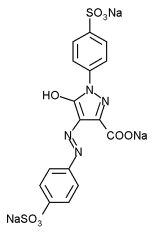| VIAS Encyclopedia provides a collection of tables and definitions commonly needed in science and engineering. |

|

Home  Chemistry Chemistry  Organic Compounds Organic Compounds  Tartrazine Tartrazine |
|
| See also: Colorings | |






|
|
Tartrazine
Tartrazine appears to cause the most allergic and/or intolerance reactions of all the azo dyes, particularly amongst those with an aspirin intolerance and asthmatics. Other reactions can include migraine, blurred vision, itching, rhinitis and purple skin patches (because of this more use is now being made of E160b, Annatto). In conjunction with E210, Benzoic acid, tartrazine appears to create an overactivity in children, and is one of the colours that the Hyperactive Children's Support Group recommends be eliminated from the diet of children. Whilst being a very commonly used colour in the United Kingdom, its use is banned in Norway and Austria.
|
|
Home  Chemistry Chemistry  Organic Compounds Organic Compounds  Tartrazine Tartrazine |
|
Last Update: 2005-04-08


 Tartrazine (otherwise known as
Tartrazine (otherwise known as